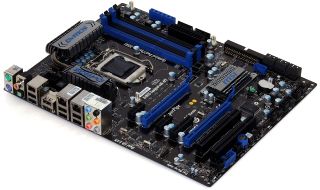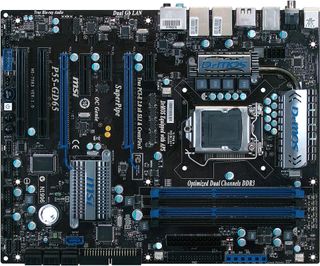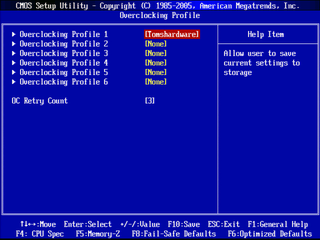Enthusiast P55: Eight LGA 1156 Boards Between $150 And $200
MSI P55-GD65
With a Web price of around $160, MSI’s P55-GD65 lacks little in the way of features compared to its more expensive competitors. Automatic PCIe pathway switching for CrossFire and SLI configurations, dual-Gigabit Ethernet network controllers, dual-format digital audio out, FireWire, and eSATA are all found onboard.

We’re sure that many readers will ask about the missing third graphics card slot included on competing Asus and EVGA models, but it’s still there. It’s harder to find, since MSI opted for an open-ended x4 connector rather than a full-length x16 slot, but it still provides the four chipset-supported pathways its competitors use. The open end still allows x8 and x16 cards to fit and, as with higher-priced Asus and EVGA models, its four PCIe lanes are still suitable only for medium-bandwidth applications like added displays or RAID controllers. The only drawback to MSI’s design is that by positioning the slot only a single space above its eight-lane x16 slot, the firm made its use practical only for single-slot cards.

A few better-planned layout decisions include Ultra ATA and floppy connectors at the P55-GD65’s front edge, just below and above the board's center line. This location makes cable installation easy, especially for those poor souls who need a floppy to add AHCI or RAID drivers during a Windows XP installation.
Not so convenient is the bottom-rear corner’s front-panel audio connector, which is most often connected to jacks at the front-top corner of a case. We’ve seen many cases with cables that won’t reach this location, yet many motherboard manufacturers continue to believe that this is where the connector belongs.
All six SATA ports point forward, and this design lends itself to extremely good cable management in most modern enthusiast-level cases. Unfortunately, the hard drive cage of some classic case designs blocks access to the motherboard’s front edge. Most builders won’t face any issues, but the potential problem is something to keep in mind when selecting components.
Several manufacturers now offer voltage rail measuring points, but MSI goes a step further by adding a convenient bracket to its CPU Core, VTT, DIMM, and PCH read points. The bracket appears to be designed to hold the probe points of typical pocket multi-meters, and it worked well for our GB unit when tested.
BIOS
Stay on the Cutting Edge
Join the experts who read Tom's Hardware for the inside track on enthusiast PC tech news — and have for over 25 years. We'll send breaking news and in-depth reviews of CPUs, GPUs, AI, maker hardware and more straight to your inbox.
MSI P55-GD65 BIOS spreads frequency and voltage settings across 2.5 pages of its Cell Menu.



We’re happy to note that, unlike the P55-CD53 reviewed last month, the P55-GD65 allows voltage to be keyed in as expected results, rather than amounts added, and that the GD65 also has the UnCore voltage setting (CPU VTT, above) missing from the cheaper CD53.
Note that Load-Line Calibration is disabled in the above screen shot. We found that enabling it has the opposite-of-expected effect, allowing CPU core-voltage droop under full load. The 1.370V setting above, with Load-Line Calibration disabled, resulted in a voltage increase to 1.45V under full load. Unload and load voltages remained stable, in spite of the difference between the two, so we had no concerns about accidental voltage changes once the two results were determined.



DRAM timings are spread across nearly three pages of the Advanced DRAM sub-menu. MSI appears not to have learned from its competitors' mistakes here, as there are no individual “auto” options for each setting. In fact, memory tuners must configure both channels independently, as MSI doesn’t have an option to group these.

P55-GD65 BIOS supports storing up to six different BIOS configurations as user profiles.
Accessories

MSI outpaces most of its competitors in its P55-GD65 installation kit by including a CrossFire bridge, in addition to SLI. The floppy cable is also a fairly rare item among modern motherboards, but could prove useful for people who still game on Windows XP and use RAID or AHCI mode for their drives. MSI even includes a compact Linux-based OS that can be run from a CD or installed to a hard drive, which the firm calls Winki.
-
skora There's two market segments. Once you get the features you need, there's overclockers, and stock users. I've never seen a mobo recommended based on its application performance and all thats looked at is how well it OCs. Hopefully, people read the article and don't just go buying biostar expecting the regular quality of gigabyte or asus though the asus is a little overpriced here for my taste. That $25 can go towards a better GPU, but I'm a gamer.Reply -
Crashman enzo matrixinterestingReply
Gigabyte had some additional interesting news about the new P55A-UD4P, where the addition of the letter "A" supposedly means "Advanced" and refers to the addition of SATA 6.0 Gb/s and USB 3.0 controllers. Unfortunately, it wasn't ready when the comparison was written. The "A" also cost slightly more. -
ibnsina For $15 more is best to go for the newly released Giga-byte GA-P55A-UD4P, the extra’s you get are:-Reply
2 x USB 3.0
2 x SATA 6Gb/s.
$184.99 on newegg. -
Crashman ibnsinaFor $15 more is best to go for the newly released Giga-byte GA-P55A-UD4P, the extra’s you get are:-2 x USB 3.0 2 x SATA 6Gb/s.$184.99 on newegg.Reply
$15 for all that sounds great, unless those features are useless to you. SATA 6.0 Gb/s will remain completely useless until long after the board is outdated, and USB 3.0 is nothing more than an eSATA substitute at the moment. -
apache_lives Why do we bitch about IDE and FDD connectors? If your using windows xp and IDE hdd/dvd drives your should be ashamed, and even then you can get USB floppys etc, and if you are using those fittings you are not getting the true performance out of your modern system, and IDE also makes boot times longer thanks to detection and legacy delays - cudos to those who ditch those ports in an effort to modernise modern systems, and to those who keep them - its like adding ISA ports to the board - times up.Reply -
cahl The new P55A-UD4P has better power phasing, 12+2 vs 8+2 on the old gigabyte UD4P, and probably more stuff aswell, like the LOTES socket, well worth the extra $15 to me.Reply -
bigballinggpr You don't bring up MSI's board at all in the conclusion. . . i'm a little curious as to what your final thoughts are on it.Reply -
Crashman apache_livesWhy do we bitch about IDE and FDD connectors? If your using windows xp and IDE hdd/dvd drives your should be ashamed, and even then you can get USB floppys etc, and if you are using those fittings you are not getting the true performance out of your modern system, and IDE also makes boot times longer thanks to detection and legacy delays - cudos to those who ditch those ports in an effort to modernise modern systems, and to those who keep them - its like adding ISA ports to the board - times up.Reply
You mean complain? Like you're complaining right now? It's all a matter of logic: There are probably more Windows XP users carrying over their old OS into a new build than there are Ultra ATA users carrying over their ancient hard drives. Therefor, the floppy interface, as outdated as it is, is more useful than the Ultra ATA interface.
The problem as described is that you PAY for an Ultra ATA controller. Why bother? Even if you're an XP devotee you probably don't WANT to pay for an Ultra ATA connector.
But for most motherboards, the floppy interface is free. It doesn't slow down boot times or performance either, if you don't need it you can ignore it.
Well, maybe you can't ignore it, but a logic dictates over emotion in reviews.
THG has no reason to love or hate the floppy connector, no stake in the legacy OS game, but anyone reader who wants to play the hater deserves to be called out for it. As for the manufacturers, honest reporting is Tom's Hardware's goal. Personally, I like the fact that some manufacturers provide legacy features and others don't, both types of products work well. -
doomtomb Replywith only a single PS/2 port left behind to support the older mice occasionally preferred by seasoned gamers
This is from the page on the EVGA P55 but you can clearly see it is a purple PS/2 port which is for keyboards... lol
Most Popular


